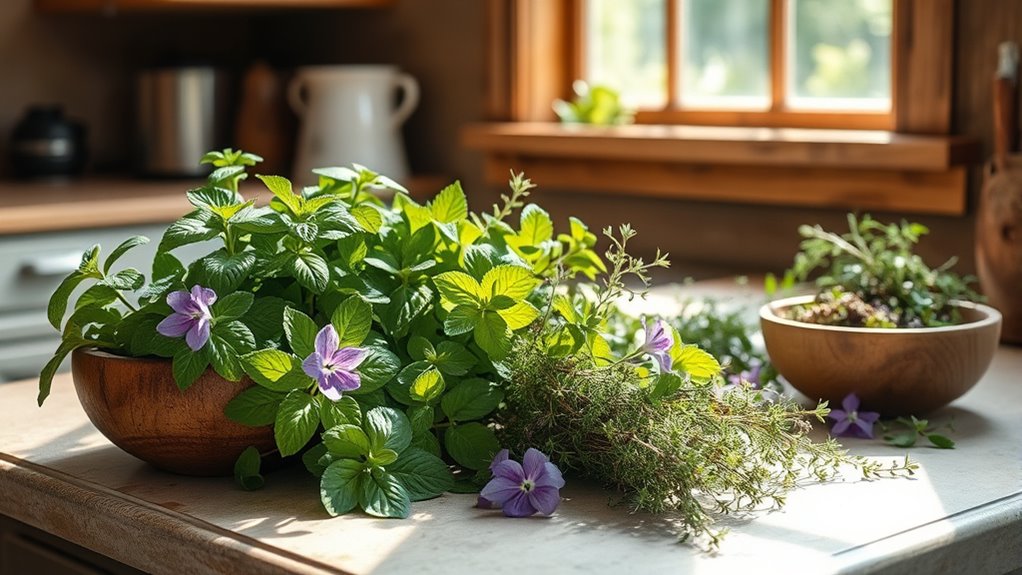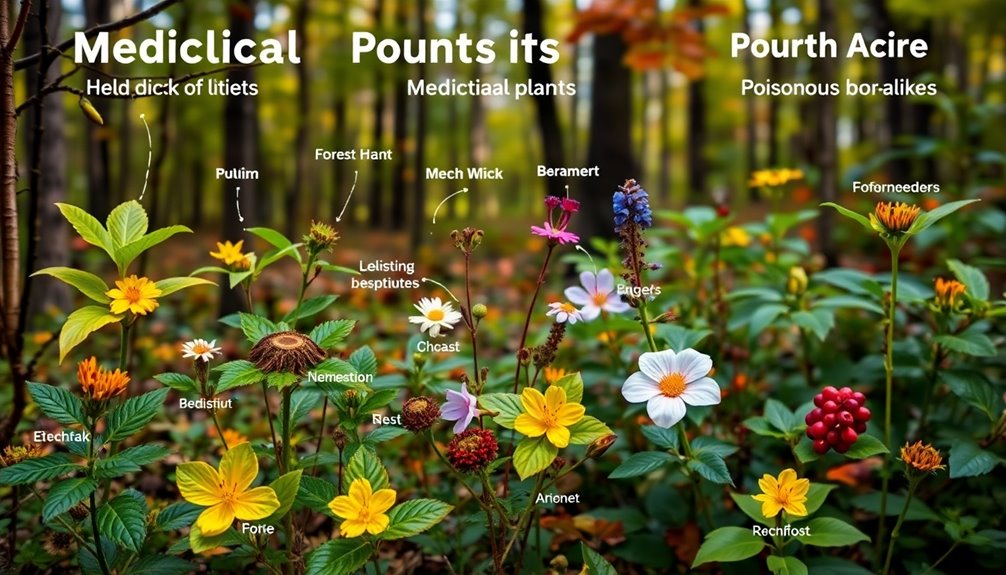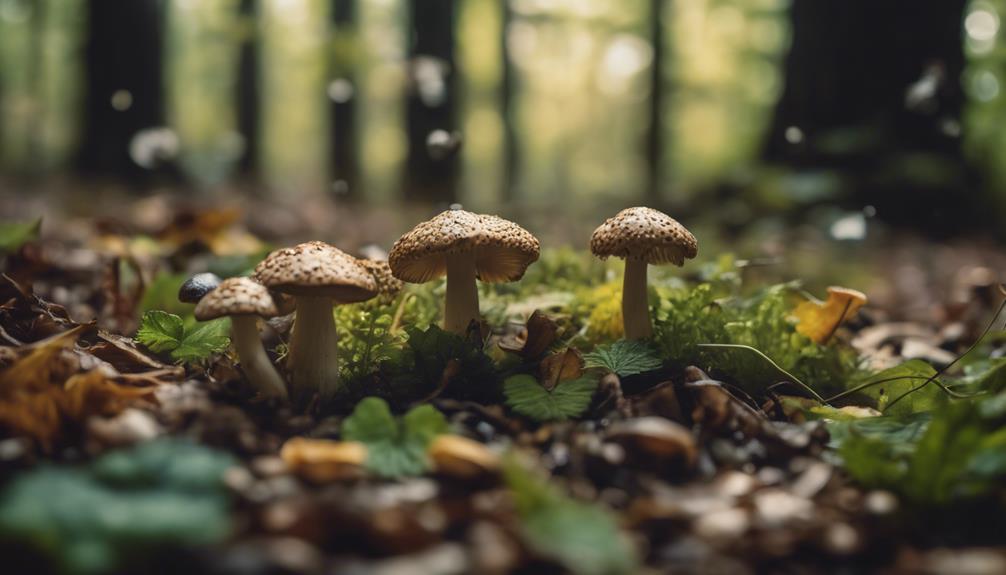You can easily replace pricey store-bought herbs with wild plant alternatives that add freshness and flavor to your dishes. Focus on foraging familiar, safe herbs like wild basil, chives, or oregano in your area, and learn to identify them correctly. Dry or freeze your harvest for longer storage and convenience. Exploring seasonal wild herbs is a sustainable, cost-effective way to enhance your cooking, and if you keep exploring, you’ll discover even more versatile options.
Key Takeaways
- Identify and forage for easily recognizable wild herbs like basil, chives, and oregano suitable for seasonal swaps.
- Use proper identification techniques and avoid plants near pollution sources to ensure safety.
- Preserve foraged herbs through drying or freezing to maintain flavor and extend shelf life.
- Incorporate wild herbs into seasonal dishes to enhance flavor and reduce reliance on store-bought options.
- Experiment with different herbs and preservation methods to develop unique, cost-effective culinary flavors.

As the seasons change, it’s the perfect opportunity to refresh your wardrobe and home with seasonal swap-ins. But why stop there? You can also enhance your cooking by replacing pricey store-bought herbs with wild plant alternatives. Foraging for herbs in the wild is both economical and rewarding, but it requires some knowledge. That’s where foraging tips come in. First, learn to identify safe, edible plants in your area. Focus on easily recognizable herbs like wild basil, chives, or oregano, which grow abundantly in many regions. Always verify plant identification through multiple sources before harvesting, and avoid plants near busy roads or contaminated areas. Once you’ve gathered your herbs, the next step is applying preservation techniques so you can enjoy their flavors long after the season ends.
Preservation techniques are essential for making the most of your foraged herbs. Drying is one of the simplest methods; hang small bunches upside down in a well-ventilated, dark space. This helps retain flavor and potency while preventing mold. Alternatively, you can use a dehydrator if you prefer a quicker process. Once dried, crumble the herbs and store them in airtight containers away from light and moisture. Freezing is another effective preservation method—chop fresh herbs and place them in ice cube trays with a little water or olive oil. When frozen, pop out the cubes and store them in labeled bags or containers. This way, you’ll have ready-to-use wild herbs for soups, stews, or teas whenever you need them.
Understanding plant identification is crucial for safe foraging and ensuring you’re harvesting edible herbs. These techniques not only extend the shelf life of your foraged herbs but also lock in their fresh, vibrant flavors. When incorporating wild herbs into your cooking, start small to gauge their strength, as they can be more potent than store-bought varieties. Use your preserved herbs in place of traditional store-bought options, and experiment with different combinations to develop your own signature flavors. Remember, foraging is an ongoing process—regularly exploring your local environment will help you discover new herbs and plants that can diversify your culinary repertoire. With a little practice and attention to safety, foraging and preservation techniques can become a sustainable, cost-effective way to enrich your seasonal menus. Plus, it’s a great way to connect with nature and enjoy the changing seasons in a truly hands-on way.
Frequently Asked Questions
How Do Wild Plant Flavors Compare to Store-Bought Herbs?
You might wonder how wild plant flavors compare to store-bought herbs. While wild plants can offer fresh, intense flavors, it’s vital to prioritize foraging safety to avoid toxic look-alikes. Generally, wild herbs have a more vibrant, complex taste, but they can vary depending on season and location. Always verify plant identification and harvest responsibly to enjoy their unique flavors safely and confidently.
Are Wild Plants Safe to Forage Without Expertise?
Imagine walking through a lush, green forest where every leaf whispers secrets. While foraging safety is vital, you shouldn’t forage wild plants without proper plant identification skills. Misidentifying plants can lead to poisoning. Even seasoned foragers recommend learning from experts or reputable guides. Trust your knowledge, stay cautious, and remember that wild plants offer rich flavors only when correctly identified and safely prepared.
What Are the Best Preservation Methods for Wild Herbs?
To preserve your wild herbs effectively, you should consider drying techniques like air-drying or using a dehydrator, which retain flavor and aroma. Freezing methods, such as chopping herbs and storing them in ice cube trays with water or oil, work well for long-term storage. make sure you clean herbs thoroughly and label containers. These methods keep your wild herbs fresh and flavorful, ready for use in cooking whenever you need them.
How Do Seasonal Changes Affect Wild Plant Availability?
You’ll notice seasonal changes impact wild plant availability through seasonal foraging, which varies with climate and growth cycles. Plant adaptation plays a role as wild herbs adapt to weather shifts, causing some to flourish while others become scarce. By understanding these patterns, you can plan your foraging accordingly, harvesting herbs at their peak and preserving them for later use, ensuring a steady supply regardless of seasonal fluctuations.
Can Wild Plant Swap-Ins Be Used in All Recipes?
Like Alice exploring Wonderland, you might wonder if wild plant swap-ins fit into all recipes. While they add unique flavors, you should consider foraging etiquette and sustainable harvesting to avoid harm. Not every wild plant works as a substitute for store-bought herbs, especially in delicate dishes. Use wild plants thoughtfully, respecting nature’s balance, and always verify their safety before incorporating them into your recipes.
Conclusion
Next time you’re staring at those sky-high herb prices, remember these wild plant swap-ins. Imagine turning your garden or forest into a treasure trove of flavor, with herbs so fresh and abundant, they could fuel a culinary revolution! Say goodbye to empty wallets and hello to a world where nature’s bounty transforms your dishes into masterpieces. Immerse yourself in wild foraging, and watch your meals become legendary — all without spending a dime!










